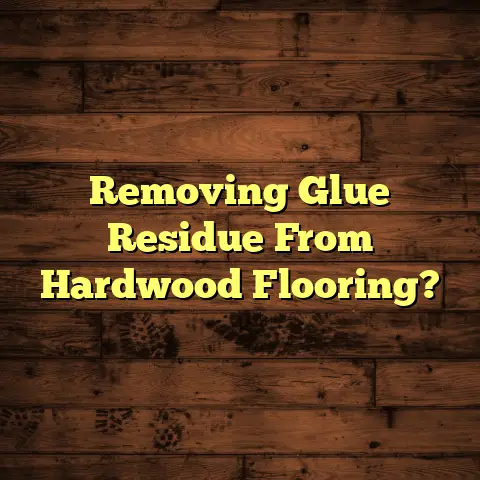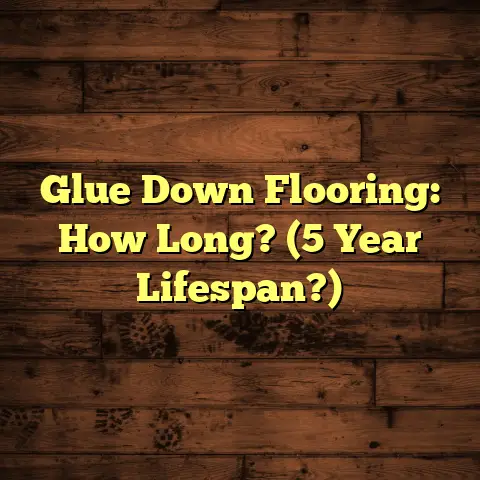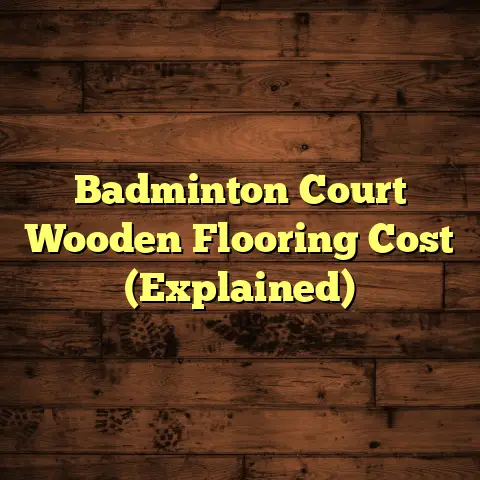Squeaky Floors Meaning? (2 Hidden Issues!)
We all dream of that perfect home, right? A space that reflects our style, our achievements, and most importantly, provides ultimate comfort. It’s about creating a sanctuary where you can truly relax and recharge.
Think about it: a well-maintained home isn’t just about aesthetics; it’s about enhancing your entire lifestyle. From the paint on the walls to the landscaping outside, every detail contributes to your overall well-being.
And when it comes to home comfort, your flooring plays a HUGE role. It’s the foundation (pun intended!) upon which your daily life unfolds.
But what happens when that foundation starts… talking back? I’m talking about squeaky floors.
Now, I know what you might be thinking: “Squeaky floors? That’s just an old house thing, right?” Well, not exactly.
While a little bit of creaking might add character, persistent or loud squeaks can be more than just an annoyance. They can be a sign of deeper issues lurking beneath the surface, issues that could undermine both the comfort and the value of your home.
In my years as a flooring contractor, I’ve seen it all. And believe me, those squeaks are often whispering secrets about problems you really want to address.
So, let’s dive into the world of squeaky floors. We’ll explore what they mean, what hidden issues they might be signaling, and most importantly, what you can do about them.
Get ready to become a squeak detective!
Section 1: Understanding Squeaky Floors
Okay, so what are squeaky floors, exactly? It seems obvious, but let’s define it.
Simply put, squeaky floors are floors that emit a noticeable squeaking or creaking sound when you walk across them.
These sounds can range from a subtle chirp to a downright ear-splitting scream (we’ve all been there, right?).
They usually occur in specific areas, like near doorways, hallways, or high-traffic zones. But sometimes, they can seem to pop up randomly, making you feel like your house is haunted.
Now, the type of flooring you have plays a big role in whether or not it’s prone to squeaking. Let’s break it down:
-
Hardwood: This is probably the most common culprit. Hardwood squeaks often arise from wood rubbing against wood, nails, or the subfloor. Changes in humidity can also cause wood to expand and contract, leading to squeaks.
-
Laminate: Laminate flooring can squeak if it’s not properly installed or if the subfloor is uneven. The squeaking sound is usually caused by the laminate planks rubbing against each other or the subfloor.
-
Tile: While tile itself doesn’t usually squeak, the subfloor underneath can. Also, loose tiles can sometimes create a clicking or popping sound that might be mistaken for a squeak.
-
Carpet: Carpet itself doesn’t squeak, but if the subfloor underneath is the problem, you might still hear squeaks.
-
Vinyl: Similar to laminate, vinyl flooring can squeak if it’s not properly installed or if there are issues with the subfloor.
So, what actually causes the squeak? It’s all about friction and vibration.
When you walk across a floor, you’re applying pressure. If there are loose components, like floorboards or nails, they’ll rub against each other. This friction creates vibrations, which we hear as a squeak.
Think of it like rubbing two pieces of wood together. The rougher the surfaces, the louder the squeak, right? It’s the same principle with your floors.
The key takeaway here is that squeaking is almost always a sign that something is moving when it shouldn’t be. And that movement, however small, can indicate a bigger problem.
Section 2: The Importance of Addressing Squeaky Floors
Now, I get it. You’re busy. You have a million things on your to-do list. Addressing squeaky floors might seem like a low priority.
But trust me, ignoring those squeaks can be a costly mistake in the long run. Remember that lifestyle upgrade we talked about? Well, squeaky floors are definitely not part of that picture.
Think about it: every time you walk across that squeaky spot, you’re reminded of the imperfection in your home. It’s a constant source of annoyance that can wear you down over time.
And let’s be honest, it’s not exactly a great first impression for guests either. Imagine having friends over for dinner and all they hear is “squeak, squeak, squeak” every time someone walks by. Not exactly the ambiance you’re going for, right?
But the real reason to take squeaky floors seriously is that they can be a symptom of larger, more serious issues.
Ignoring them can lead to:
-
Further Damage: The movement that causes the squeak can gradually worsen, leading to loose floorboards, cracked tiles, or even structural damage.
-
Reduced Home Value: A home with obvious signs of disrepair, like squeaky floors, will likely fetch a lower price on the market.
-
Safety Hazards: In extreme cases, loose or damaged flooring can create tripping hazards.
-
Increased Repair Costs: Addressing the problem early is almost always cheaper than waiting until it becomes a major repair project.
Think of it like a leaky faucet. A small drip might not seem like a big deal, but if you ignore it, it can lead to water damage, mold growth, and a much bigger plumbing bill down the road.
Squeaky floors are the same way. They’re your home’s way of telling you that something needs attention.
By addressing the problem early, you can prevent further damage, maintain your home’s value, and create a more comfortable and enjoyable living space.
So, let’s get to the root of the problem. What hidden issues might those squeaks be trying to tell you about?
Section 3: Hidden Issue #1 – Structural Problems
Alright, let’s get into the nitty-gritty. One of the most common reasons for squeaky floors is underlying structural problems.
These problems can range from minor issues with loose floorboards to more serious issues with the foundation or joists.
Let’s start with the most common culprit: loose floorboards.
Over time, the nails or screws that hold your floorboards in place can loosen. This can happen due to normal wear and tear, changes in humidity, or even poor initial installation.
When the floorboards become loose, they start to rub against each other or the subfloor, creating that telltale squeaking sound.
The impact on the overall integrity of the flooring system can be significant. Loose floorboards can create uneven surfaces, which can lead to further damage to the surrounding boards. They can also make the floor feel less stable and secure.
Next up: foundation settling.
Your home’s foundation is the base upon which everything else rests. If the foundation settles unevenly, it can cause shifts in the flooring above.
This settling can put stress on the floorboards, causing them to warp, crack, or become loose. It can also affect the alignment of the joists, which can further contribute to squeaking.
According to the American Society of Civil Engineers (ASCE), most homes experience some degree of foundation settling over time. However, excessive settling can be a sign of serious problems, such as poor soil conditions or inadequate drainage.
Finally, let’s talk about joist spacing.
Joists are the horizontal beams that support your subfloor. Proper joist spacing is crucial for ensuring that your floor is stable and doesn’t flex too much when you walk on it.
If the joists are spaced too far apart, the subfloor can sag between them, creating a bouncy or squeaky feel. This is especially common in older homes where the joist spacing may not meet modern building codes.
According to the International Residential Code (IRC), the maximum allowable joist spacing depends on the size and type of joists, as well as the load they are designed to carry.
So, how can you identify these structural problems? Here are a few things to look for:
-
Visual Inspection: Look for gaps between floorboards, uneven surfaces, or signs of warping or cracking.
-
Listen Carefully: Pay attention to where the squeaks are coming from. Are they concentrated in one area, or are they spread throughout the room?
-
Check the Subfloor: If possible, access the subfloor from below (e.g., in a basement or crawl space). Look for signs of water damage, rot, or loose connections.
-
Look for Foundation Cracks: Inspect your foundation walls for cracks. While hairline cracks are normal, larger cracks can be a sign of more serious problems.
-
Bounce Test: Walk around the room and pay attention to how the floor feels. Does it feel bouncy or unstable in certain areas?
If you suspect that you have structural problems, it’s important to consult with a qualified contractor or structural engineer. They can assess the situation and recommend the appropriate repairs.
Ignoring structural problems can lead to further damage and potentially compromise the safety of your home. So, don’t hesitate to seek professional help if you’re concerned.
Section 4: Hidden Issue #2 – Moisture and Environmental Factors
The second major culprit behind squeaky floors? Moisture. I’ve seen moisture issues wreak havoc on flooring more times than I can count.
Think of wood as a sponge. It’s constantly absorbing and releasing moisture depending on the surrounding environment. And when wood gets too wet or too dry, it can cause all sorts of problems, including squeaky floors.
According to the U.S. Forest Service, wood can expand and contract by as much as 5% in response to changes in humidity. That might not sound like much, but it can be enough to cause significant problems with your flooring.
But it’s not just humidity that can cause problems. Improper ventilation and water damage can also create an environment for squeaks to thrive.
If your home isn’t properly ventilated, moisture can build up in the subfloor, creating a breeding ground for mold and rot. This can weaken the subfloor and cause the floorboards to become loose.
Water damage from leaks, spills, or flooding can also wreak havoc on your floors. Water can seep into the wood, causing it to swell and warp. This can lead to loose floorboards, cracked tiles, and a host of other problems.
So, how can you spot moisture-related issues? Here are some telltale signs:
-
Warped Floors: Look for areas where the floorboards are buckling or cupping. This is a sign that the wood has absorbed too much moisture.
-
Mold or Mildew: Check for signs of mold or mildew growth, especially in areas that are prone to moisture, such as bathrooms, kitchens, and basements.
-
Water Stains: Look for water stains on the ceiling, walls, or floors. These stains can indicate a leak or other source of water damage.
-
Musty Odor: A musty odor can be a sign of mold or mildew growth.
-
Efflorescence: Efflorescence is a white, powdery substance that can appear on concrete or masonry surfaces. It’s caused by water seeping through the concrete and dissolving minerals, which are then deposited on the surface.
-
Condensation: Check for condensation on windows, walls, or pipes. This can indicate high humidity levels.
If you notice any of these signs, it’s important to take action immediately. The longer you wait, the worse the problem will become.
Here are a few things you can do to address moisture-related issues:
-
Improve Ventilation: Make sure your home is properly ventilated. Use exhaust fans in bathrooms and kitchens to remove moisture.
-
Control Humidity: Use a dehumidifier to control humidity levels in your home, especially during the summer months.
-
Fix Leaks: Repair any leaks in your roof, plumbing, or foundation.
-
Clean Up Spills: Clean up any spills immediately to prevent water damage.
-
Dry Out Wet Areas: If your floors get wet, dry them out as quickly as possible. Use fans and dehumidifiers to speed up the drying process.
In some cases, you may need to replace damaged flooring or subflooring. If you’re not comfortable doing this yourself, it’s best to hire a qualified contractor.
Addressing moisture-related issues is crucial for preventing further damage to your home and maintaining a healthy living environment. So, don’t ignore the signs. Take action today to protect your investment.
Section 5: The Psychological Impact of Squeaky Floors
Okay, we’ve covered the structural and environmental factors that can cause squeaky floors. But let’s not forget about the psychological impact.
I know it might sound silly, but living with squeaky floors can actually take a toll on your mental well-being. Think about it: your home is supposed to be your sanctuary, a place where you can relax and recharge.
But when you’re constantly hearing those annoying squeaks, it can be hard to feel at peace. It’s like a constant reminder that something is wrong, even if you can’t quite put your finger on it.
The correlation between a well-maintained home environment and mental well-being is well-documented. Studies have shown that people who live in clean, organized, and well-maintained homes tend to be happier and less stressed.
Conversely, people who live in cluttered, disorganized, or poorly maintained homes are more likely to experience stress, anxiety, and depression.
According to a study published in the journal Environment and Behavior, people who live in homes with unresolved maintenance issues reported higher levels of stress and lower levels of life satisfaction.
The study found that even minor annoyances, like squeaky floors, can contribute to a sense of unease and dissatisfaction with one’s living environment.
It’s all about creating a sense of control and order in your life. When your home is in good repair, you feel like you have a handle on things. But when things start to fall apart, it can create a sense of chaos and overwhelm.
Think about it like this: your home is a reflection of your inner state. If your home is cluttered and disorganized, it can be a sign that you’re feeling overwhelmed and stressed in other areas of your life.
Similarly, if your home is well-maintained and organized, it can be a sign that you’re feeling calm, centered, and in control.
So, don’t underestimate the power of a well-maintained home. It’s not just about aesthetics; it’s about creating a space that supports your mental and emotional well-being.
Addressing even minor annoyances, like squeaky floors, can make a big difference in how you feel about your home and your life.
It’s about taking pride in your living space and creating a sanctuary that you can truly enjoy.
Section 6: Conclusion
So, there you have it. We’ve explored the meaning behind squeaky floors and the hidden issues they may represent.
From structural problems to moisture issues to the psychological impact, we’ve covered a lot of ground.
The key takeaway is that squeaky floors are not just a minor annoyance. They’re a sign that something is wrong, and they should be addressed promptly.
Ignoring those squeaks can lead to further damage, reduced home value, and a negative impact on your mental well-being.
Investing time and resources into home maintenance, including addressing squeaky floors, is an essential part of enhancing one’s lifestyle.
It’s about taking pride in your home and creating a space that you can truly enjoy.
Remember, your home is your sanctuary. It’s a place where you can relax, recharge, and be yourself.
By taking proactive steps to maintain its integrity, you’re investing in your own well-being and creating a more comfortable and enjoyable living space.
So, the next time you hear those squeaks, don’t just ignore them. Take action. Investigate the problem, identify the cause, and take steps to fix it.
Your home will thank you for it. And more importantly, you’ll thank yourself for it.
Now, go forth and conquer those squeaks! Your home (and your sanity) will be better for it.





